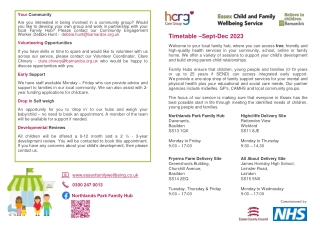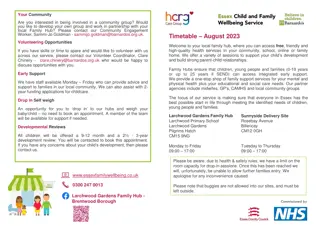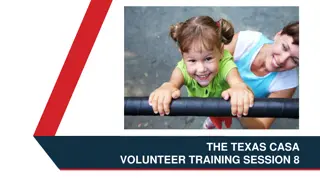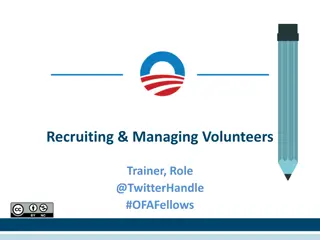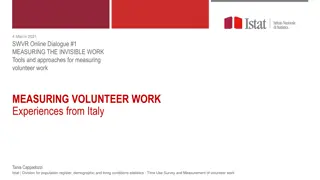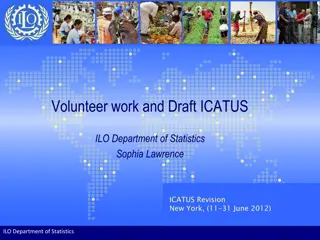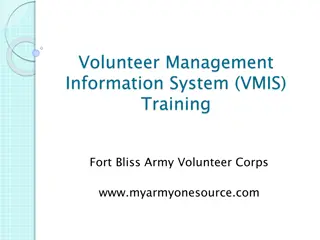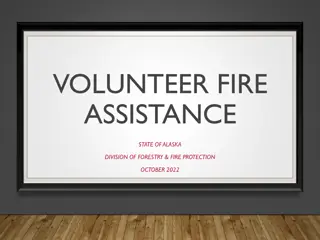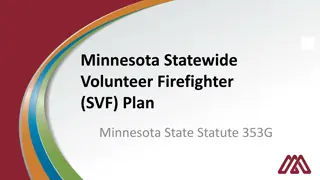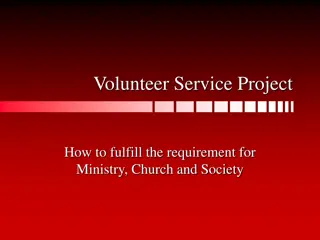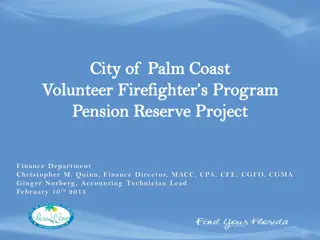
Empowering Strategies for Addressing Homelessness
Explore impactful strategies for addressing homelessness through modules covering PIT counts, community advocacy, resource allocation, and outreach efforts. Learn who to count, who not to count, and how to effectively engage stakeholders in creating positive change.
Download Presentation

Please find below an Image/Link to download the presentation.
The content on the website is provided AS IS for your information and personal use only. It may not be sold, licensed, or shared on other websites without obtaining consent from the author. If you encounter any issues during the download, it is possible that the publisher has removed the file from their server.
You are allowed to download the files provided on this website for personal or commercial use, subject to the condition that they are used lawfully. All files are the property of their respective owners.
The content on the website is provided AS IS for your information and personal use only. It may not be sold, licensed, or shared on other websites without obtaining consent from the author.
E N D
Presentation Transcript
Strategies For Change thn.org
Module 1 Module 2 Module 3 Winter PIT Count Date: Module 4 1/23/2025 Module 5 Module 6 Wrap- Up
Module 1 Point-in-Time (PIT) Basics Module 2 How many people are currently experiencing homelessness in your community? How many of them are families, youth, or veterans? What do they report as their causes for homelessness? Module 3 Module 4 The answers to these questions and more can be answered by point-in- time counts. Module 5 A point-in-time count is an unduplicated count on a single night of the people in a community who are experiencing homelessness Module 6 Wrap- Up
Module 1 Advocate to local governments Raise Community Awareness Module 2 Awareness Module 3 Characteristics of those experiencing homelessness locally Trends in Homelessness over time Extent Module 4 Advocate for private or local government funds Eligibility for CoC, ESG, and other federal funding Funding Module 5 Develop personal relationships with those experiencing homelessness Module 6 Create a sense of responsibility with varied stakeholders Engagement Wrap- Up
Module 1 Who to Contact Module 2 If you have questions about: Count Logistics Who & where we count Survey length/questions Identifying hot spots Technical issues If you have questions about: Community Information Shift times HQ location Assigned count areas Module 3 Module 4 If you can t reach your PIT Lead: Module 5 Data Manager PIT Lead Module 6 If you can t reach the Data Manager Wrap- Up THN Administrator
Who to Count Module 2 Individuals residing in: Module 3 Sheltered Locations Unsheltered Locations Module 4 Module 5 -Emergency Shelter - Domestic Violence Shelter - Transitional Housing -Street -Outdoor Encampment -Other places not meant for habitation Hotel/Motel paid for by an Agency Voucher Module 6 Wrap- Up
Who NOT to Count Module 2 Individuals residing in: Module 3 Temporary Situations Permanent Housing Module 4 Module 5 - Doubled Up with family or friends - At-risk of homelessness - Hotel/motel paid by own funds - Shelters designed for foster care -Sober living/ halfway houses - Criminal Justice or Health facilities - PSH or RRH Programs - HUD VASH projects -FEMA projects Module 6 Wrap- Up
Youth Specific Considerations Who counts? children and youths are living in motels, hotels, trailer parks, or camping grounds due to the lack of alternative adequate accommodations; are living in emergency or transitional shelters children and youths who have a primary nighttime residence that is a public or private place not designed for or ordinarily used as a regular sleeping accommodation for human beings children and youths who are living in cars, parks, public spaces, abandoned buildings, bus or train stations, or similar settings; and migratory children Module 2 Who doesn t count? Children and youth who are sharing the housing of other persons Children and youth who are abandoned in hospitals; or are awaiting foster care placement Module 3 Module 4 Module 5 Module 6 Wrap- Up
Unsheltered PIT Planning A count of people who are unhoused but not in a shelter or transitional housing program is referred to as an unsheltered count. Module 3 Module 4 The unsheltered count requires identification of persons that are living in places not meant for human habitation on January 23rd. Module 5 Module 6 Wrap- Up
Possible Locations Abandoned building Bus, train station, airport Park Street/sidewalk Tents Under bridge/overpass Vehicle (car, van, RV, truck) Woods/outdoor encampment Module 3 Module 4 Module 5 Module 6 Wrap- Up
Creating Known Locations Map Work together with your PIT leads to start a list of locations where you see individuals experiencing homelessness living Visit the locations at least once a month leading up to the count Visit locations several times during the week leading up to the count. Module 3 Module 4 This list will likely change over time and will need regular updates. Collaborate with your PIT leads on the best way to send your updates PIT Leads should provide you with a map as well as a list of locations on the day of the count. Module 5 Module 6 Wrap- Up
Safety Considerations Don t Wake up someone* Approach if you don t feel comfortable* Mandate participation Invade personal space Cross barriers Promise anything you can t deliver Be judgmental Give money or offer rides Share any confidential info or photos of participants Panic Put anyone in danger Deviate from the survey Do Always work in teams Be respectful of space Ask a person to participate if you think they are homeless Introduce yourself and explain what you are doing Be sincere and caring Remain calm Know how to de-escalate Know emergency numbers Honor requests to not participate Provide shelter information if possible Dress appropriately Leave valuables behind Module 3 Module 4 Module 5 Module 6 Wrap- Up
Module 3 Module 4 Module 5 Module 6 Wrap- Up
Tips and Tricks Read over all of the materials provided to you at least the night before the count Resources will also be posted on the THN website (hyperlinked) Come prepared wearing appropriate clothing, shoes, and with enough water and food for your volunteer shift. Make sure your phone/smart device is charged and bring portable charger if possible. Have the app downloaded and be logged in prior to going to your headquarters location Practice, Practice, Practice Have your introductory script ready Practice reading through the survey questions out loud Reach out to PIT leads if you have any questions or concerns in advance of the count. Module 3 Module 4 Module 5 Module 6 Wrap- Up
Sheltered PIT Planning HUD defines sheltered homeless persons as adults, children, and unaccompanied children who, on the night of the count, are living in shelters for the homeless. Regardless of funding source, all providers of shelter, vouchers, or funds for shelters (including motel/hotel rooms), and/or transitional housing need to provide unduplicated information about the individuals and families on January 23rd, 2025. Module 4 To be considered for the PIT Count: 1. The primary intent of the project is to serve literally homeless persons, 2. The project verifies homeless status as part of its eligibility determination, and 3. The actual project clients are predominantly homeless (or, for permanent housing, were homeless at entry). Module 5 Module 6 Wrap- Up
Locations Emergency Shelters: means any facility, the primary purpose of which is to provide a temporary shelter for the homeless in general or for specific populations of the homeless and which does not require occupants to sign leases or occupancy agreements. o Domestic violence shelters o Hotel, motel, or apartment vouchers paid for by a public or private agency because the individual or family is homeless Module 4 *For Emergency Shelters, you should conduct the surveys in the late afternoon/evening when participants are checking in to stay the night. Module 5 Transitional Housing: is designed to provide homeless individuals and families with the interim stability and support to successfully move to and maintain permanent housing. Transitional housing may be used to cover the costs of up to 24 months of housing with accompanying supportive services. Program participants must have a lease (or sublease) or occupancy agreement in place when residing in transitional housing. Module 6 Wrap- Up
Locations Continued Your PIT Lead should be providing you with a list of agencies prior to the day of the count. If you have not received a list please contact your PIT lead. If you believe there is an agency that should be on this list, please contact your PIT Lead and they will reach out to me if necessary. To view the list of agencies that participated last year, please visit the THN website and download the Housing Inventory Count (HIC) Report Link to website Module 4 **If you represent an agency that provides Hotel/Motel vouchers for individuals experiencing homelessness, please contact me ASAP** Module 5 Module 6 PIT HIC Who & Capacity for Crisis Measures People Measures Housing Wrap- Up
PIT Count Vs. HIC Module 4 Module 5 Module 6 Wrap- Up
Domestic Violence Protocol Notice CPD 17-08: HUD is requiring that data reported on survivors of domestic violence should be limited to reporting on those who are currently experiencing homelessness because they are fleeing domestic violence, dating violence, sexual assault, or stalking, as opposed to reporting on survivors who have ever experienced these circumstances. Question on the survey: Are you currently staying in this shelter because of domestic violence? (Including: dating violence, sexual violence, and/or stalking) Module 4 Module 5 Module 6 Wrap- Up
Surveying Survivors Do Explain that the survey is confidential and all identifying information is removed for their safety. Use their initials or a code for their name (if they don t want to give you their initials). Fill out their age range. NOT THEIR EXACT AGE Complete the remainder of the survey with them. Write in the notes section of the survey that they are a survivor so I can make sure their location is secure. Provide any information on support that your PIT lead provided you Don t Fill in their full name Fill in their date of birth Fill in their exact age Provide any identifying information in the notes section Do not fill out any personal identifying information Pressure participants into answering any questions they don t feel comfortable answering. Express disbelief or pity to answers on the survey by survivors. Module 4 Module 5 Module 6 Wrap- Up
App Screenshot Module 4 Module 5 Module 6 Wrap- Up
Tips and Tricks Verify list of agencies for your community prior to the PIT count. Contact your PIT Lead if one appears to be missing. Work with your PIT Lead to set up either a phone call or a visit with each shelter you plan to count at. Take note of their confidentiality protocols as well as their visitor policy. Be respectful and follow the direction of shelter staff at all times. Module 4 Maintain contact with your assigned shelter leading up to the count. Identify the time you will be helping survey and how long they anticipate needing your assistance. Module 5 Module 6 Wrap- Up
Unsheltered and Sheltered Counts Do Don t Do not complete a survey without consent Do not continue the survey if the individual has expressed the desire to end the survey Do not complete a survey based on an intake form unless you have specifically obtained consent to do so. If you have obtained consent Module 4 Module 5 Module 6 Wrap- Up
Observation Survey Do Someone is sleeping You do not feel comfortable going to a certain area A person did not give their consent to participate in the survey or they don t want to complete the survey in it s entirety Someone does not seem to understand the consent process and cannot reasonably consent to the survey. Don t Fill out an observation survey if you have not laid eyes on the individual that day Module 4 Module 5 Module 6 Wrap- Up
Complete Sheltered Survey If you are in a Sheltered location Person Consented to survey Complete Unsheltered Survey If you are at an Unsheltered location Complete Observation Survey Person did not consent to survey Safe to approach Module 4 Person could not consent to survey -They were sleeping and/or they did not understand the consent process Complete Observation survey Encounter someone you believe is experiencing homelessness Module 5 Thank them for their time. DO NOT COMPLETE A SURVEY Person reported that they are not experiencing homelessness Module 6 Complete Observation survey Wrap- Up Unsafe to approach
Best Practices for Sheltered Count Familiarize yourself with the survey Practice reading all of the questions out loud. Practice giving your introduction script out loud. Communicate your intentions to prospective survey participants Obtain consent to administer the survey Express confidence and compassion When surveying individuals within a group, prioritize safety and protect participant s information Whenever possible, attempt to give participants as much privacy as they request. Know volunteer expectations Know community resources Review this training again in the month of January to refresh your knowledge Module 4 Module 5 Module 6 Wrap- Up
Next Steps Watch the mobile app training video(s) The mobile app training is linked here or on our website Register for the PIT Count https://txbos25.pointintime.info/ Work with your PIT leads to start mapping hot spot locations There are a series of additional presentations posted to the website to help you engage those with lived experience, youth, veterans, and victim service providers. There will be additional refresher materials released in January of 2025. Please visit our PIT website to view these materials linked here Wrap- Up
Contact Information Ava Paredes Data Coordinator Thank you! Email: Ava@thn.org Phone: (512) 652-4714 @thn.org Strategies For Change thn.org

